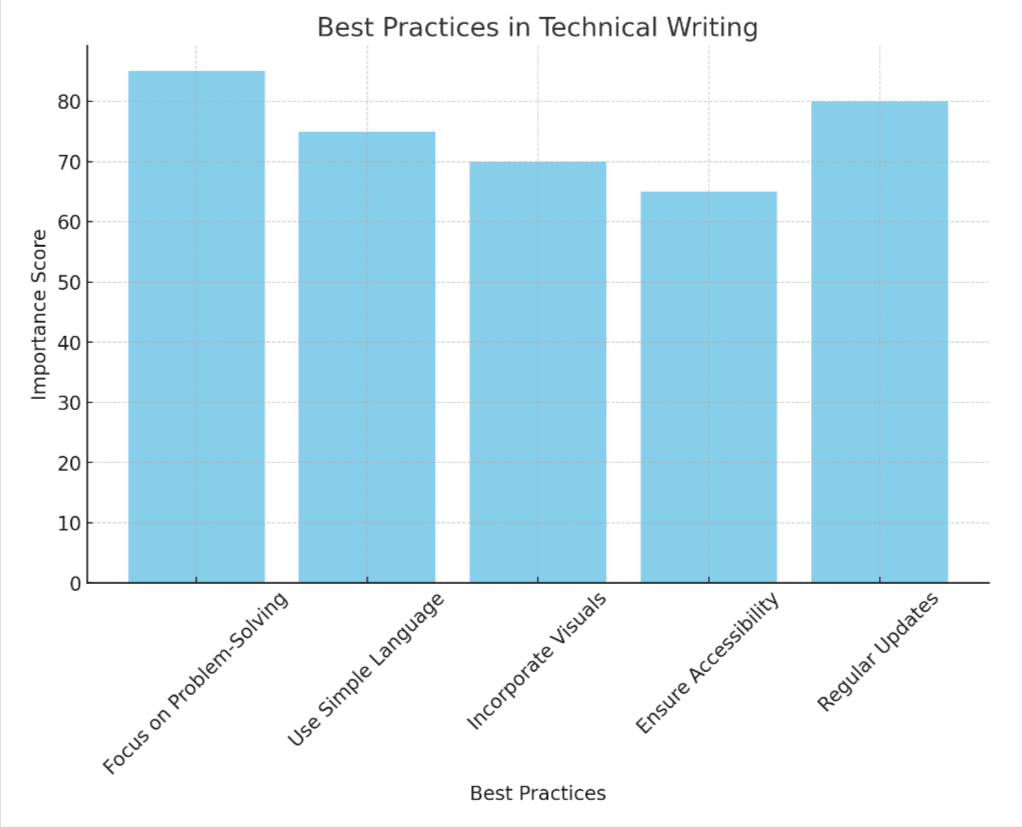The Art and Science of Technical Writing for Manuals and Guides
Struggling to explain complex products can leave users scratching their heads. Did you know effective technical manuals turn confusion into clarity? This post guides you through crafting clear, helpful manuals that make life easier for everyone.
Dive in – simplicity awaits!
Key Takeaways
- Technical manuals are important tools for explaining how to use products safely and effectively. They come in many types, including instructional guides, user manuals, and reference guides.
- Writing technical documentation clearly with simple language and visuals improves the learning experience for users. Using step-by-step instructions helps people understand complex tasks easily.
- To keep a technical manual up-to-date and useful, gather feedback from users regularly. Update the content based on this feedback and any new information about the product or industry standards.
- Accessibility is key in technical writing; make sure your manual can be understood by as many people as possible by using clear language and providing safety information prominently.
- Use specialized software tools to create professional – looking manuals that are easy to follow. These help organize content logically and add helpful elements like diagrams or videos.
What is a Technical Manual?
A technical manual is a document that provides detailed instructions on how to use, maintain, or troubleshoot a product or system. It serves as a reference guide for users and technicians, providing valuable information about the product’s features and functions.
Definition and purpose
A technical manual serves as a comprehensive guide detailing essential information about a product, system, or procedure. It covers the setup, operation, and maintenance aspects of the subject in question to aid users in understanding and using it effectively.
The purpose is twofold: first, to provide clear step-by-step instructions that can optimize user experience; second, to serve as a reliable reference guide whenever troubleshooting or deeper knowledge of the product is required.
It’s not just about helping users figure out how something works; these manuals play a critical role in ensuring safety by alerting users to potential hazards associated with incorrect use.
They also form an integral part of technical communication between the manufacturer and the user by addressing common issues and offering solutions which ultimately contribute to product longevity and customer satisfaction.
Types of technical manuals
Technical manuals come in various forms, each tailored to specific needs. They cater to diverse audiences, from beginners to experts.
- Instructional Guide: This manual offers step-by-step instructions on how to perform tasks or use products. It’s ideal for teaching new users the basics with clear, easy-to-follow language.
- How-to Manual: Similar to instructional guides, these manuals focus on completing specific projects or processes and often include troubleshooting tips.
- Reference Guide: A reference guide compiles critical information, allowing users to quickly find answers without reading through extensive text.
- User Guide: A user guide provides comprehensive details on a product’s features and functions, helping customers get the most out of their purchase.
- Technical Documentation: These documents dive into the technicalities behind products or systems, useful for maintenance and advanced understanding.
- User Manual: Often included with products, this manual familiarizes users with equipment or software and guides them through initial setup and use.
- Procedure Manual: This type of manual outlines established methods for performing operations within an organization, ensuring consistency and quality.
- Writing Style Guide for Technical Documentation: It assists writers in maintaining a consistent voice, making technical content easier to understand and globally accessible.
- Product Manuals: These are focused on a single product, detailing everything from installation to maintenance and advanced operations.
Benefits of Investing in Technical Manuals
Investing in technical manuals can lead to quick and easy onboarding of users, improve customer experience, ensure safe operation, provide effective training materials, and reduce liability.
Technical manuals are essential tools for enhancing the overall user experience and maintaining safety standards.
Quick and easy onboarding of users
Technical manuals streamline the user onboarding process by providing clear and concise instructions. A well-crafted manual guides new users through product features, helping them become proficient quickly.
This immediate understanding builds confidence in your product, encouraging continued use and satisfaction.
Effective technical writing for manuals ensures that instructions are easy to follow. Users can dive right into using your product without confusion or frustration, thanks to straightforward step-by-step guidance.
Clear visuals complement the text, allowing users to visualize what they need to do next, making the learning curve much smoother.
Improving customer experience
To enhance the user experience, technical manuals should focus on clarity and ease of understanding. Providing clear and concise instructions, along with visual aids, can significantly improve users’ ability to navigate the product or process.
Engaging language and a user-centric approach help in creating manuals that empower users to troubleshoot issues independently.
Incorporating customer feedback into the manual design is essential for ensuring that their needs are met effectively. By incorporating real-life scenarios and addressing common pain points, technical manuals become more relatable and useful for customers looking for solutions to their problems.
Ensuring safe operation
To ensure safe operation, technical manuals should include comprehensive guidelines on proper equipment handling, maintenance protocols, and safety precautions. Clear and concise instructions addressing potential hazards must be provided to prevent accidents and injuries.
Incorporating visual aids such as diagrams, warning symbols, and safety icons can effectively communicate critical safety information to users. Additionally, the manual should outline emergency procedures and troubleshooting steps to help users respond appropriately in challenging situations.
Furthermore, including detailed precautions for specific tasks or equipment operation is essential for promoting a safe working environment. Providing user-friendly safety information ensures that operators are well-informed about potential risks associated with product usage and can take necessary precautions to avoid accidents or damage.
Effective training materials
When creating technical manuals, it’s essential to develop effective training materials that cater to diverse learning styles. Including clear and concise instructions, illustrations, and interactive elements can enhance user comprehension.
By ensuring your training materials are accessible and engaging, you can equip users with the knowledge needed for successful product usage.
Moving on to “Avoiding liability,” let’s explore how technical manuals help organizations mitigate risks associated with product misuse.
Avoiding liability
To avoid liability, ensure that your technical manual includes clear warnings and safety precautions for product operation. Incorporate easily understandable language and visual aids to convey potential risks to users, emphasizing the importance of following instructions.
Address any potential hazards associated with product use or misuse, outlining proper procedures for safe operation. Regularly update the manual to reflect any changes in safety regulations or industry standards, ensuring that your documentation aligns with current best practices.
By including comprehensive information on safety measures and risk mitigation in your technical manuals, you can protect both users and your company from potential liabilities. Providing clear guidelines and warnings reduces the likelihood of accidents or misuse, establishing a proactive approach to user safety within your documentation.
How to Create a Technical Manual
Identify your target audience and design a template that suits their needs. Outline the purpose of the product or feature, incorporate step-by-step instructions, utilize visuals and peer review, gather user feedback, and make sure to maintain updates for an effective technical manual creation process.
Identifying your target audience
Understanding your target audience is crucial when creating technical manuals. Identify the specific users who will rely on the manual, considering their knowledge level and technical expertise.
Tailoring the language, tone, and depth of information to match their needs ensures that the manual effectively serves its purpose. By defining your target audience clearly, you can craft a user-centered manual that addresses their concerns and provides meaningful guidance.
Identifying your readership’s expectations helps in structuring content that resonates with them. Being mindful of their requirements enables you to focus on what matters most to them when designing a technical manual.
Designing a template
After identifying your target audience, designing a template is the next crucial step in creating an effective technical manual. The template serves as the framework for organizing and presenting information in a clear and consistent manner.
Start by determining the sections needed, including an introduction, table of contents, troubleshooting guide, and maintenance instructions. Use headings and subheadings to divide content logically.
Incorporate bullet points or numbered lists to present steps or procedures in a structured format that is easy for users to follow.
Outlining product/feature purpose
When outlining the purpose of a product or feature in a technical manual, it is essential to clearly define its function and how it benefits the user. This involves explaining how the product or feature addresses specific needs or solves particular problems for the end-user.
Identifying and articulating the purpose with precision ensures that users understand its relevance and encourages them to engage effectively with the technical documentation.
By outlining the product’s purpose in a user-friendly manner, technical writers can effectively communicate why the product exists, what it does, and how it adds value to the user’s experience.
Incorporating step-by-step instructions
To incorporate step-by-step instructions into a technical manual, follow these guidelines:
- Begin with a clear and concise introduction to the procedure, outlining the end goal.
- Use numbered or bulleted lists to break down each step, making the process easy to follow.
- Include detailed descriptions of each step, ensuring all necessary actions are clearly explained.
- Utilize relevant visuals such as diagrams or screenshots to visually demonstrate the steps.
- Provide examples or scenarios to illustrate how the steps are applied in real – life situations.
- Ensure consistency in formatting and style throughout the manual for a uniform look and feel.
- Test the instructions with individuals who are unfamiliar with the product to verify clarity and ease of understanding.
Utilizing visuals and peer review
To enhance the effectiveness of technical manuals, incorporating visuals is crucial. Visual aids such as images, diagrams, and infographics help users comprehend complex instructions more easily.
They can also serve as universal language for users who have difficulty understanding written text. Peer review is equally important in refining the content of technical manuals. When colleagues or subject matter experts review the document, they can offer valuable feedback to ensure accuracy, clarity, and completeness before finalizing the manual.
Visuals enrich user comprehension while peer reviews enhance accuracy and clarity in technical manuals. Both are essential components in creating high-quality and user-friendly documentation.
Gathering user feedback and maintaining updates
Gathering user feedback and maintaining updates are crucial for improving the effectiveness of your technical manual. This helps to ensure that your manual stays relevant and helpful for its users. Here are some key pointers for gathering user feedback and maintaining updates:
- Encourage users to provide feedback through surveys, user testing, or feedback forms on your manuals.
- Regularly review and analyze customer support inquiries and common issues to identify areas for improvement.
- Utilize analytics tools to track user engagement with the manual, including page views, time spent on each page, and search queries.
- Actively seek input from customer service representatives or technical support teams who interact with users regularly.
- Keep abreast of industry developments and technological advancements that may impact the content of your manual.
- Incorporate user feedback into updates by revising content, adding new sections, or clarifying ambiguous instructions.
- Implement a structured process for version control and distribution of updated manuals to ensure all users have access to the most recent information.
Best Practices for Writing a Technical Manual
Addressing problems should be the main focus of your technical manual, presenting instructions sequentially in simple language and visuals. Ensuring accessibility and safety information, as well as using tools for creating and publishing manuals, are also essential best practices to keep in mind.

Focusing on addressing problems
Address problems by clearly identifying potential issues that users may encounter when following the instructions. Use troubleshooting sections to guide users through solving common problems they may face.
Provide practical solutions and workarounds for any technical difficulties that users might experience, ensuring a positive user experience.
By anticipating and addressing potential challenges, you can empower users to overcome obstacles independently, leading to increased confidence in using the product or service. Making problem-solving an integral part of your technical manual can significantly improve user satisfaction and reduce support inquiries.
Presenting instructions sequentially
To present instructions sequentially, start by organizing the steps logically. Use clear and concise language in each step, ensuring that the progression from one task to another is easy to follow.
Incorporating visual aids such as diagrams or videos can further clarify the sequence of actions. Additionally, consider using numbering or bullet points to indicate the order in which tasks should be performed.
When creating a technical manual, remember that presenting instructions sequentially allows users to easily follow along with the process. Using simple language and visuals also enhances understanding, making it easier for your audience to comprehend complex procedures.
Using simple language and visuals
Craft your technical manual with a clear, straightforward language that is easy for your audience to understand. Use visuals such as diagrams, charts, and images to illustrate complex concepts and step-by-step instructions.
Ensure that the text complements the visuals, making your manual accessible to a wide range of users.
By incorporating simple language and visuals in your technical manual, you can effectively convey information and guide users through processes without overwhelming them with unnecessary complexity or confusing jargon.
This approach enhances user experience and makes the content more engaging for readers seeking comprehensive guidance.
Ensuring accessibility and safety information
To ensure accessibility and safety information in technical manuals, use clear and simple language to cater to a wide range of users. Incorporate visual aids such as diagrams, charts, and images to enhance understanding for those with different learning styles.
Additionally, provide detailed safety instructions prominently within the manual to minimize potential hazards or risks associated with product usage.
Crafting easy-to-understand content enables all users, including those with disabilities or language barriers, to access vital safety information. Furthermore, integrating clear accessibility guidelines ensures compliance with industry standards and regulations while promoting user inclusivity.
Using tools for creating and publishing manuals
To create and publish manuals efficiently, writers can utilize various tools such as Adobe InDesign, Microsoft Word, or MadCap Flare. These software offer features for formatting text, inserting visuals, and organizing content in a user-friendly manner.
It’s important to choose a tool that aligns with the manual’s purpose and audience needs. Additionally, online publishing platforms like WordPress or Medium provide options for sharing manuals digitally, making them easily accessible to users.
By leveraging these tools effectively, technical writers can streamline the process of creating and publishing manuals while ensuring high-quality output that meets the needs of their target audience.
Conclusion
In conclusion, technical manuals play a crucial role in guiding users through product usage. They enhance customer experience and ensure safe operation. By focusing on best practices for writing clear and accessible instructions, companies can create effective technical manuals that benefit both users and the business.
Technical writing for manuals is an essential aspect of ensuring user satisfaction and successful product implementation.

